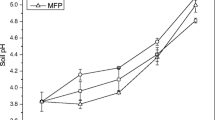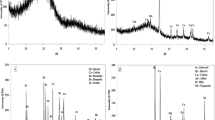Abstract
A complete orthogonal experiment using a pot test is conducted to investigate the effects of four amendments (biochar, peat, manure, and non-contaminated soil (NCS)) on the metal availability, mobility, and phytostabilization potential of an energy crop, king grass (Pennisetum purpureum × P. thyphoideum), in Pb/Zn mine tailings. The addition of amendments significantly increased the pH and fertility of the tailings, while significantly decreasing the heavy metal available contents in the tailings. The available Cd, Pb, Zn, and As concentrations in the tailings in the treatment amended with biochar+NCS+peat+manure were 51.00%, 36.62%, 50.57%, and 75.88%, respectively, lower than those in the treatment control. The king grass survived in the tailings without amendments, while amendments made the plant grow well or better in the tailings than in NCS. The addition of amendments significantly reduced the content of heavy metals and bioaccumulation factor (BCF) in the plant root but increased the translocation factor (TF) of Cd, Zn, and As and had little effect on the TF of Pb. The TF for heavy metals in plant were lower than one for all of the treatments. During a leaching period of 30 days, the pH of the leachate declined slowly and then maintained at 6.0~6.6. The addition of the amendments significantly reduced the metal concentrations of the leachates, and the highest declines were 50.46%, 20.04%, 41.58%, and 47.04% for Cd, Pb, Zn, and As, respectively. Biochar had a higher immobilization capacity for Cd, Pb, Zn, and As than manure, peat, and NCS. King grass could be used to aid phytostabilization for Cd- and Pb-polluted tailings, and biochar-rich amendments were effective for the in situ immobilization of metals. Further field monitoring is necessary to demonstrate the effectiveness of king grass and amendments under the climatic conditions of China.








Similar content being viewed by others
References
Abreu CAD, Coscione AR, Pires AM, Paz-Ferreiro J (2012) Phytoremediation of a soil contaminated by heavy metals and boron using castor oil plants and organic matter amendments. J Geochem Explor 123:3–7
Alagić SČ, Tošić SB, Dimitrijević MD, Nujkić MM, Papludis AD, Fogl VZ (2018) The content of the potentially toxic elements, iron and manganese in the grapevine cv Tamjanika growing near the biggest copper mining/metallurgical complex on the Balkan peninsula: phytoremediation, biomonitoring and some toxicological aspects. Environ Sci Pollut R 25(34):34139–34154
Alford ER, Pilon-Smits EAH, Paschke MW (2010) Metallophytes – a view from the rhizosphere. Plant Soil 337:33–50
Ali H, Khan E, Sajad MA (2013) Phytoremediation of heavy metals—concepts and applications. Chemosphere 91:869–881
Baker DE, Amacher MC (1982) Nickel, copper, zinc, and cadmium. In: Page AL, Miller RH, Keeney DR (eds) Methods of soil analysis. Part 2 Chemical and Microbiological Methods. American Society of Agronomy/Soil Science Society of America, Madison, pp 323–336
Barajas-Aceves M, Camarillo-Ravelo D, Rodríguez-Vázquez R (2015) Mobility and translocation of heavy metals from mine tailings in three plant species after amendment with compost and biosurfactant. Soil Sediment Contam 24(3):223–249
Beauchemin S, Clemente JS, MacKinnon T, Tisch B, Lastra R, Smith D, Kwong J (2015) Metal leaching in mine tailings: short-term impact of biochar and wood ash amendments. J Environ Qual 44:275–285
Beesley L, Marmiroli M (2011) The immobilisation and retention of soluble arsenic, cadmium and zinc by biochar. Environ Pollut 159:474–480
Beesley L, Moreno-Jiménez E, Gomez-Eyles JL, Harris E, Robinson B, Sizmur T (2011) A review of biochars’ potential role in the remediation, revegetation and restoration of contaminated soils. Environ Pollut 159:3269–3282
Bradl HB (2004) Adsorption of heavy metal ions on soils and soils constituents. J Colloid Interface Sci 277:1–18
Cousins C, Penner GH, Liu B, Beckett P, Spiers G (2009) Organic matter degradation in paper sludge amendments over gold mine tailings. Appl Geochem 24:2293–2300
Dastyar W, Raheem A, He J, Zhao M (2019) Biofuel production using thermochemical conversion of heavy metal-contaminated biomass (HMCB) harvested from phytoextraction process. Chem Eng J 358:759–785
Elouear Z, Bouhamed F, Bouzid J (2014) Evaluation of different amendments to stabilize cadmium, zinc, and copper in a contaminated soil: influence on metal leaching and phytoavailability. Soil Sediment Contam 23:628–640
Forján R, Asensio V, Rodríguez-Vila A, Covelo EF (2016) Contribution of waste and biochar amendment to the sorption of metals in a copper mine tailing. Catena 137:120–125
Galende MA, Becerril JM, Barrutia O, Artetxe U, Garbisu C, Hernandez A (2014) Field assessment of the effectiveness of organic amendments for aided phytostabilization of a Pb-Zn contaminated mine soil. J Geochem Explor 145:181–189
Gil-Loaiza J, White SA, Root RA, Solís-Dominguez FA, Hammond CM, Chorover J, Maier RM (2016) Phytostabilization of mine tailings using compost-assisted direct planting: translating greenhouse results to the field. Sci Total Environ 565:451–461
Grottola CM, Giudicianni P, Pindozzi S, Stanzione F, Faugno S, Fagnano M, Fiorentino N, Ragucci R (2019) Steam assisted slow pyrolysis of contaminated biomasses: effect of plant parts and process temperature on heavy metals fate. Waste Manag 85:232–241
Houben D, Pircar J, Sonnet P (2012) Heavy metal immobilization by cost-effective amendments in a contaminated soil: effects on metal leaching and phytoavailability. J Geochem Explor 123:87–94
Lee SH, Ji WH, Lee WS, Koo N, Koh IH, Kim MS, Park JS (2014) Influence of amendments and aided phytostabilization on metal availability and mobility in Pb/Zn mine tailings. J Environ Manag 139:15–21
Li J, Yu GW, Xie SY, Pan LJ, Li CX, You FT, Wang Y (2018) Immobilization of heavy metals in ceramsite produced from sewage sludge biochar. Sci Total Environ 628–629:131–140
Li XF, Huang LB (2015) Toward a new paradigm for tailings phytostabilization—nature of the substrates, amendment options, and anthropogenic pedogenesis. Crit Rev Environ Sci Technol 45(8):813–839
Liu GS (1996) Soil physical and chemical analysis and description of soil profiles. Standards Press of China, Beijing
Liu WJ, Tian K, Jiang H, Zhang XS, Ding HS, Yu HQ (2012) Selectively improving the bio-oil quality by catalytic fast pyrolysis of heavy-metal-polluted biomass: take copper (Cu) as an example. Environ Sci Technol 46:7849–7856
Marques APGC, Rangel AOSS, Castro PML (2009) Remediation of heavy metal contaminated soils: phytoremediation as a potentially promising clean-up technology. Crit Rev Environ Sci Technol 39:622–654
Mignardi S, Corami A, Ferrini V (2013) Immobilization of Co and Ni in mining-impacted soils using phosphate amendments. Water Air Soil Pollut 224:1447
National Standardization Committee. 1995. National standard of the people’s Republic of China: environmental quality standards for soils (GB15618–1995) in China. (in Chinese)
Norton GJ, Adomako EE, Deacon CM, Carey AM, Price AH, Meharg AA (2013) Effect of organic matter amendment, arsenic amendment and water management regime on rice grain arsenic species. Environ Pollut 177:38–47
Office of national soil survey (1997) Soil survey data of China. Agricultural Press of China, Beijing (in Chinese)
Park JH, Choppala GK, Bolan NS, Chung JW, Chuasavathi T (2011a) Biochar reduces the bioavailability and phytotoxicity of heavy metals. Plant Soil 348:439–451
Park JH, Lamb D, Paneerselvam P, Choppala G, Bolan N, Chung JW (2011b) Role of organic amendments on enhanced bioremediation of heavy metal(loid) contaminated soils. J Hazard Mater 185:549–574
Pérez-Esteban J, Escolástico C, Moliner A, Masaguer A, Ruiz-Fernández J (2014) Phytostabilization of metals in mine soils using Brassica juncea in combination with organic amendments. Plant Soil 377:97–109
Pichtel J, Bradway DJ (2008) Conventional crops and organic amendments for Pb, Cd and Zn treatment at a severely contaminated site. Bioresour Technol 99:1242–1251
Prasad MNV (2003) Phytoremediation of metal-polluted ecosystems: hype for commercialization. Russ J Plant Physiol 50:686–700
Puga AP, Melo LCA, de Abreu CA, Coscione AR, Paz-Ferreiro J (2016) Leaching and fractionation of heavy metals in mining soils amended with biochar. Soil Tillage Res. https://doi.org/10.1016/j.still.2016.01.008
Rodríguez L, Gómez R, Sánchez V, Alonso-Azcárate J (2016) Chemical and plant tests to assess the viability of amendments to reduce metal availability in mine soils and tailings. Environ Sci Pollut Res 23:6046–6054
Schwab P, Zhu D, Banks MK (2007) Heavy metal leaching from mine tailings as affected by organic amendments. Bioresour Technol 98:2935–2941
Sheoran V, Sheoran A, Poonia P (2011) Role of hyperaccumulators in phytoextraction of metals from contaminated mining sites: a review. Crit Rev Environ Sci Technol 41:168–214
Tošić S, Alagić S, Dimitrijević M, Pavlović A, Nujkić M (2016) Plant parts of the apple tree (Malus spp.) as possible indicators of heavy metal pollution. AMBIO 45(4):501–512
Vamerali T, Bandiera M, Mosca G (2010) Field crops for phytoremediation of metal-contaminated land. A review. Environ Chem Lett 8:1–17
Walker DJ, Clemente R, Bernal MP (2004) Contrasting effects of manure and compost on soil pH, heavy metal availability and growth of Chenopodium album L. in a soil contaminated by pyritic mine waste. Chemosphere 57:215–224
Weyens N, van der Lelie D, Taghavi S, Newman L, Vangronsveld J (2009) Exploiting plant microbe partnerships to improve biomass production and remediation. Trends Microbiol 27(10):591–598
Xu Y (2017) Stabilization of heavy metal-contaminated sediment with a chelator and humic acid mixture. Water Air Soil Pollut 228:20
Xu XY, McGrath SP, Meharg AA, Zhao FJ (2008) Growing rice aerobically markedly decreases arsenic accumulation. Environ Sci Technol 42:5574–5579
Zhang XF, Zhang XH, Gao B, Xia HP, Li ZA, Li HF, Li J (2014) Effect of cadmium on growth, photosynthesis,mineral nutrition and metal accumulation of an energy crop, king grass (Pennisetum americanum × P. purpureum). Biomass Bioenergy 67: 179–187
Zhang XF, Tian C, Gao B (2017a) Heavy metal tolerance and phytoremediation potential of energy crop, king grass. Chinese J Environ Eng 11(5):3204–3213 (in chinese)
Zhang XF, Zhang XH, Chen ZG (2017b) Biosorption of Cr(VI) from aqueous solution by biochar derived from the leaf of Leersia hexandra Swartz. Environ Earth Sci 76:67
Zhang XF, Zhang XH, Huang K (2016) Phytostabilization of acidic soils with heavy metal contamination using three forage grasses in combination with organic and inorganic amendments. Soil Sediment Contam 25(4):459–475
Acknowledgments
The authors are grateful to the anonymous reviewers for valuable comments on the manuscript.
Funding
The project was supported by the Natural Science Foundation of Guangxi (2018GXNSFAA138045), the Guangxi Science Technology Major Project (GuikeAA17204047), the Guangxi Science Technology Project (Guikezhuan1599001-1), the Program for High Level Innovation Team and Outstanding Scholar of Universities in Guangxi (GuiCaiJiaoHan[2018]319), the Natural Science Foundation of Guangxi (2018GXNSFAA138202), and the National Key Research and Development Program of China (2016YFD0800800).
Author information
Authors and Affiliations
Corresponding author
Additional information
Responsible Editor: Philipp Gariguess
Publisher’s note
Springer Nature remains neutral with regard to jurisdictional claims in published maps and institutional affiliations.
Rights and permissions
About this article
Cite this article
Gao, B., Zhang, X., Tian, C. et al. Effects of amendments and aided phytostabilization of an energy crop on the metal availability and leaching in mine tailings using a pot test. Environ Sci Pollut Res 27, 2745–2759 (2020). https://doi.org/10.1007/s11356-019-07171-x
Received:
Accepted:
Published:
Issue Date:
DOI: https://doi.org/10.1007/s11356-019-07171-x




